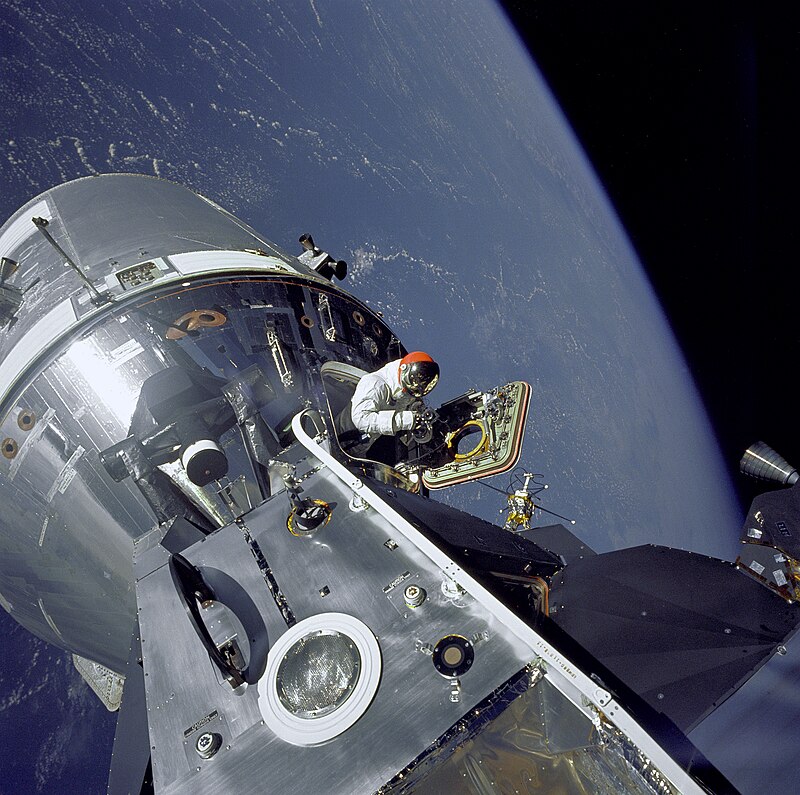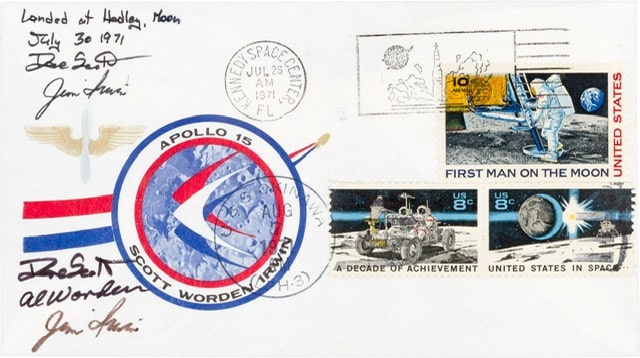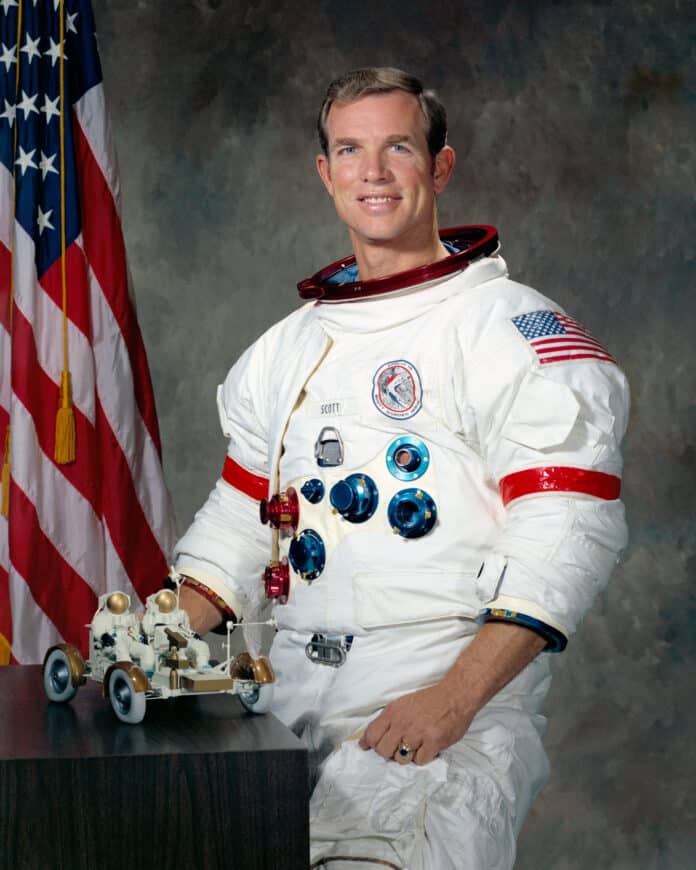There are four men still living who have set foot on the lunar surface; Originally, there were twelve. David Scott is someone who can still tell us what it was like. At age 91, he’s the seventh man to walk on the moon.
David Randolph Scott was born on June 6, 1932. He graduated from the University of Michigan and went on to West Point. He joined the United States Air Force and had a successful career. He qualified as a fighter pilot and a test pilot. He was an Air Force Colonel before joining NASA.
In 1963, Scott was part of NASA Group 3. These men were chosen to complete the current Gemini projects and start on the Apollo programs. They were considered the best of the best. One man of Scott’s NASA Group 3 was a relative unknown named Buzz Aldrin, who would later be the second man to set foot on the moon.
It’s interesting to note the strict selection process for astronauts in the 1960s. You were required to be a US citizen and have a degree in either engineering or the physical or biological sciences. You had to have a minimum of 1,000 flight hours or to have been a test pilot. There were also age and height restrictions. Each applicant had to be younger than age thirty-five and no more than six feet tall. Of the original 720 applicants for NASA Group 3, only 490 met all requirements. Later, as the selection process continued, the number of applicants was down to 136. Finally, NASA chose its “top 34” picks- all men. So, what about women in space? Women of the 1960s were not prevented from applying to NASA, but they just couldn’t get anywhere during that era. They couldn’t get the jet test pilot experience they needed to qualify. It just wasn’t possible. Yet.
The 34 prospective applicants for NASA Group 3 were called in for further evaluation. They underwent extensive medical, physical, and psychological testing. Based on the results, NASA chose 13 new astronauts. However, that seemed like an unlucky number, so one more individual was added to the list. The final total was fourteen. There were seven men from the Air Force, including David Scott. Additional future astronauts included four men from the Navy, one from the Marines, and two civilians.
In March of 1966, David Scott had his first mission. He and Neil Armstrong (from NASA Group 2) orbited Earth in Gemini 8. Together, they spent eleven hours in space and were recognized as the first individuals to link two spacecraft together in Earth’s orbit. Their three-day mission was cut short due to issues with the spacecraft’s maneuverability. It was the first time a US-manned flight was shortened for any reason.
David Scott and Neil Armstrong became fast friends as fellow astronauts. Their relationship lasted a lifetime until Armstrong’s death in August of 2012. Scott was quoted as saying he couldn’t imagine any other individual being the first man to walk on the moon. The honor seemed tailor-made for his dear friend, Neil Armstrong.
In March of 1969, Scott had his second mission. He spent ten days in orbit as part of a three-man crew on Apollo 9. This mission tested maneuvers critical to moon landings, including flying independently, rendezvousing, and docking. This was the first flight of the entire Apollo spacecraft. It had both a command and service module and a lunar module.
In July of 1971, Scott had his third and final mission. He was the commander of the three-man Apollo 15. Much had changed in the “space race” since the early 1960s. Television coverage was bigger and better than ever. There was more of it, live and in color! In all, there were eleven television shows, amounting to over twenty hours of live coverage for Apollo 15. Daily itineraries were published in the newspapers, and space coverage was listed in the TV guides. We knew, hour by hour, how the astronauts spent their time.
During Apollo 15, Scott was the first man to drive on the moon. He had a sweet ride, an eight-million-dollar electric car called the Rover 1. This go-kart style vehicle, though costing millions, had a stick for steering. And it contained a color camera attached to its bumper. With Rover 1, Scott and fellow astronaut James Irwin were able to travel farther on the lunar surface than any mission ever before. They stayed longer on the moon than ever before, too. Fellow astronaut Alfred Worden orbited above them in the main spacecraft. Meanwhile, Scott and Irwin gathered over 250 lbs. of moon rocks, including a rare crystal-filled rock believed to have been formed close to the moon’s creation. It’s often called their big find, a “Genesis Rock.”
Apollo 15 had many “firsts,” including the first camera positioned to catch a glimpse of the lunar module as it blasted off from the moon. This was the first time America saw a lunar module blast off and head back toward Earth.
Scott also conducted a physics experiment on the moon. He showed us that a hammer and a feather would accelerate equally in the moon’s gravity. The moon’s gravity is one-sixth that of planet Earth. When dropped from waist height, a hammer and a feather would hit the ground simultaneously despite their weight and mass differences. Early astronomer Galileo (1564-1642) conducted a similar experiment by dropping those same objects from the Leaning Tower of Pisa in Italy.
Despite all its accomplishments, Apollo 15 had “poor judgment” moments of controversy. The astronauts carried with them some 400 unauthorized postal covers (envelopes) to the moon and received payment for doing so. The souvenir covers were postmarked with the date of the morning’s launch and spent three days on the moon inside the Falcon rocket. After splashdown, the covers were postmarked again on the recovery carrier USS Okinawa and some were sold for profit.
A closed session of a Senate committee did a full investigation. The three astronauts returned all monies and were reprimanded. They were denied the General Thomas D. White US Air Force Space Trophy. They were also removed from consideration as backup crew for Apollo 17. James Irwin and Alfred Worden (part of NASA Group 5) and David Scott (NASA Group 3) never flew in space again.
David Scott retired from NASA in 1977 at the age of 45. In later years, he was able to be a consultant on the 1995 movie “Apollo 13” directed by Ron Howard and starring Tom Hanks, Kevin Bacon, Bill Paxton, and Gary Sinise.
Scott recalls fondly his days in one-sixth gravity driving Rover 1. He remembers walking on the lunar surface and compares it to walking on a trampoline here on Earth. He is the only living commander of a spacecraft that has landed on the moon and shares some insights as to what happened to our “space race” and why man hasn’t been on the moon for 50 years.
Scott relates that the moon missions were getting harder and harder to complete. Many people had worked on them from the beginning and were getting tired. Parts for various spacecraft were getting harder to obtain. Some space companies went out of business. I guess it was just time to step back for a while.
Now it seems time to get back into space. Private companies like SpaceX have sent up over 80 launches of the Falcon 9 or Falcon Heavy rockets since January 2023 and are not done yet. You can search online to find the next Space Coast launch. (https://www.visitspacecoast.com )
Meanwhile, NASA still looks for the best and brightest. In 2017, they reported that out of 18,300 applicants, only 12 new astronauts were chosen to fly. Less than 1 percent. A very elite group!
“Man must explore, and this is exploration at its greatest.” …….David Scott


[Credit: NASA]

